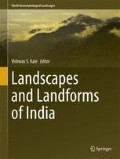Abstract
The Belum and Bora Caves of Andhra Pradesh form exemplary karst features of great research importance to earth and archeological sciences, besides being attractive tourist destinations. These caves were formed by the dissolution of carbonate rocks (such as limestones and dolomites) through the action of groundwater. This process has contributed to the creation of a variety of surface and sub-surface features. The karstic features in and around these caves include karren, sinkholes, dolines, disappearing streams and karst springs. Sub-surface features include large caves with impressive speleothems (stalagmites and stalactites). These karstic features probably developed during more moist periods in the past. Subsequent change in climate to semi-aridity likely reduced the rate of dissolution of the carbonate to the currently observed rates.
Access this chapter
Tax calculation will be finalised at checkout
Purchases are for personal use only
References
Dar FA, Perrin J, Riotte J, Gebauer HD, Narayana AC, Ahmed S (2011) Karstification in the Cuddapah sedimentary basin, Southern India. Implications for groundwater resources. Acta Carsologica 40:457–472
Durand N, Ahmad SM, Hamelin B, Curmi P (2006) Origin of Ca in South Indian calcretes developed on metamorphic rocks. J Geochem Explor 88:275–278
Gebauer HD (1985) Kurnool 1984: report of the speleological expedition to the district of Kurnool, Andhra Pradesh, India. Abhandlungen zur Karst und Höhlenkunde (Essays on the karst and speleology), vol. 21, Munchen, Germany, pp. 77
Narayana AC, Tiwari M, Yadava MG, Ngugen DC, Shen CC, Sarang PB, Ramesh R (2011) Stable isotopic variations of a stalagmite from Belum Cave, India: potential for monsoon reconstruction. In: AGU Fall Meeting, San Francisco, pp 31C–1886
Sinha A, Cannariato KG, Stott LD, Cheng H, Edwards RL, Yadava MG, Ramesh R, Singh IB (2007) A 900 year (600–1500 A.D.) record of the Indian summer monsoon precipitation from the core monsoon zone of India. Geophys Res Lett 34:L16707. doi:10.1029/2007GL030431
Sushmitha B, Baskar R, Kaushik A (2007) Evidences for microbial involvement in the genesis of speleothem carbonates, Borra Caves, Visakhapatnam, India. Curr Sci 92:350–355
Yadava MG, Ramesh R (2006) Stable oxygen and carbon isotope variations in speleothems as monsoon proxies: a comparative study of four different locations in India. J Geol Soc Ind 68:461–475
Yadava MG, Saraswat KS, Singh IB, Ramesh R (2007) Evidences of early human occupation in the limestone caves of Bastar, Chhattisgarh. Curr Sci 92:820–823
Author information
Authors and Affiliations
Corresponding author
Editor information
Editors and Affiliations
Rights and permissions
Copyright information
© 2014 Springer Science+Business Media Dordrecht
About this chapter
Cite this chapter
Narayana, A.C., Yadava, M.G., Dar, F.A., Ramesh, R. (2014). The Spectacular Belum and Borra Caves of Eastern India. In: Kale, V. (eds) Landscapes and Landforms of India. World Geomorphological Landscapes. Springer, Dordrecht. https://doi.org/10.1007/978-94-017-8029-2_19
Download citation
DOI: https://doi.org/10.1007/978-94-017-8029-2_19
Published:
Publisher Name: Springer, Dordrecht
Print ISBN: 978-94-017-8028-5
Online ISBN: 978-94-017-8029-2
eBook Packages: Earth and Environmental ScienceEarth and Environmental Science (R0)

